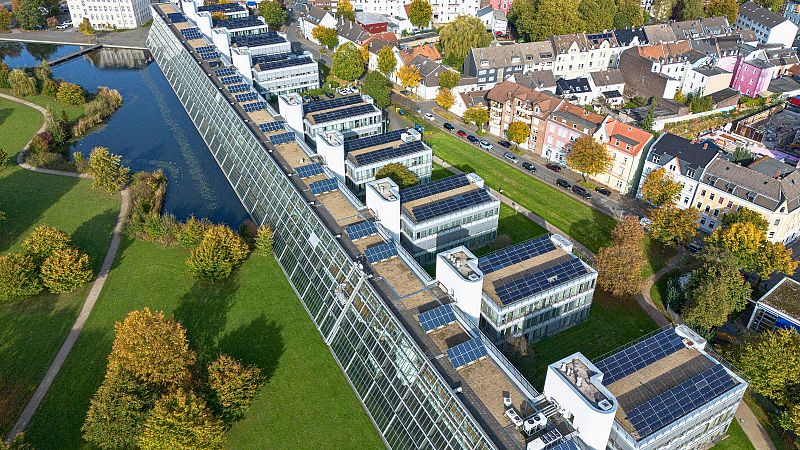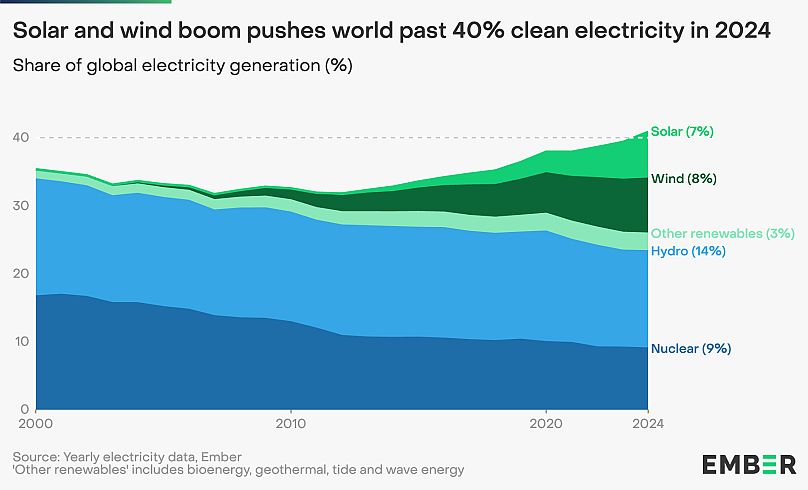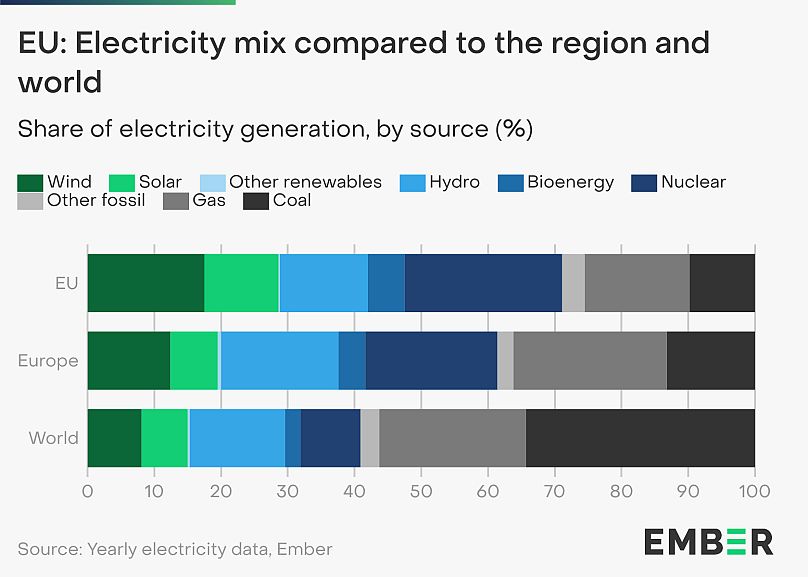
The world generated more than 40 per cent of its electricity from low-carbon sources last year, according to new analysis from clean energy think tank Ember. That’s a record not broken since the 1940s, when the global electricity system was 50 times smaller than it is today, and hydropower did the heavy lifting.
Now, it’s solar energy that is soaring in a targeted race to build an entirely clean electricity system. Global solar generation has become large enough to power all of India, Ember’s latest Global Electricity Review finds.
Power sector emissions also reached an all-time high last year, however, at 14.6 billion tonnes of CO2. This was mainly driven by a need for cooling technology during heatwaves, as 2024 turned into the hottest year on record - underscoring the urgency of the energy transition.
The EU is well ahead of the global average, having generated 71 per cent of its electricity from clean sources in 2024, which include nuclear.
“Europe has cemented a global leadership in clean power,” Dr Beatrice Petrovich, senior analyst at Ember tells Euronews Green. Furthermore, “it is showing the world how to have an increasing share of renewables in the mix”, with nearly half (47 per cent) from solar, wind and hydro last year.
‘Solar is not one country’s story’
Solar generation in the EU almost doubled in the three years to 2024 to account for 11 per cent of electricity, surpassing coal for the first time.
Seven member states rank among the top 15 countries with the highest shares of solar generation worldwide. In short, Petrovich says, “the EU is a solar superpower.”

There are national achievements to spotlight. In absolute terms, Germany generated 71 TWh of solar last year, coming in sixth place globally, with all countries dwarfed by China’s 834 TWh output.
Hungary has the world’s highest share of solar in its electricity mix, at 25 per cent. This was due to a generous incentive scheme for residential solar that boosted capacity, Petrovich explains. It’s over now, but the panels will keep doing their job for decades.
Spain, meanwhile, gets the prize for Europe’s biggest increase in solar generation last year. Its 10 TWh surge is again eclipsed by China’s 250 TWh. China was responsible for more than half of the global change in generation - an astonishing 53 per cent - in 2024.
But, in Europe at least, “solar is not one country’s story,” Petrovich emphasises. “Widespread growth really says something about how flexible this technology is, how scalable this technology is,” she says. “There is a kind of a solar story in every country now.”
Even with less optimal weather conditions compared to 2023, an increase in panels - including on rooftops - led to more electricity being generated. There is no slow down in the growth of the EU’s solar capacity yet, despite the high penetration rate.
California, a blueprint for the EU?
Now it’s time for Europe to show the world how to bring clean power to the next level, says Petrovich. That means having even more solar and wind in the mix and the flexibility to make the most of them.
This means a portfolio of solutions, including batteries for energy storage, smart electrification of transport, buildings and industry, and an enhanced grid to shift electricity around regions.
“We have the world's largest grid. Now we need to make it smarter,” Petrovich says, partly by removing barriers.
Solutions that reward people for switching their consumption to times when renewables are plentiful could also help - for example, price incentives that encourage drivers to charge their EVs during the day instead of the night.

The necessary technology already exists, Petrovich adds, and one place that provides a blueprint is California. Last year, the US state’s combination of solar and batteries meant that a fifth of its peak electricity demand in the evening was met by batteries charged around midday.
Just three years ago that number was only two per cent - which is currently the situation for some key markets in Europe getting into big battery technology, such as Ireland.
“‘Maybe California offers a sneak preview of what we are going to see in Europe in three years' time,” she suggests.
Clean power is up to global challenges, from AI to Russia
There are many uncertainties about what the future holds and how the energy story will unfold in 2025.
Emerging technologies such as AI, data centres, electric vehicles and heat pumps are already contributing to the rise in global demand, the report flags.
The former two are particularly “unknown”, but Ember foresees that clean power growth is fast enough to support the rate of increasing electricity demand.
Heatwaves were the main driver of the small rise in fossil fuel power last year and are likely to increase as the climate crisis deepens. But that doesn’t have to mean a catch-22 fall back on fossil fuels.
“Every country is in a position to match increased demand with clean electricity,” Petrovich says. A few ingredients make that easier, she adds, such as efficient appliances for cooling.
Europe learned a “hard lesson” about energy security after Russia’s full-scale invasion of Ukraine in 2022, and has been ramping up renewables since.
“Now the situation is more tense with Russia, I think those concerns about security are really more material than they used to be and renewables are seen as this defence strategy,” says Petrovich.
Central-Eastern European countries are the ones to watch in terms of solar and batteries.
Petrovich also says she is looking forward to seeing wind - which generated 18 per cent of EU electricity - accelerate this year thanks to faster permitting and, hopefully, more favourable conditions.







